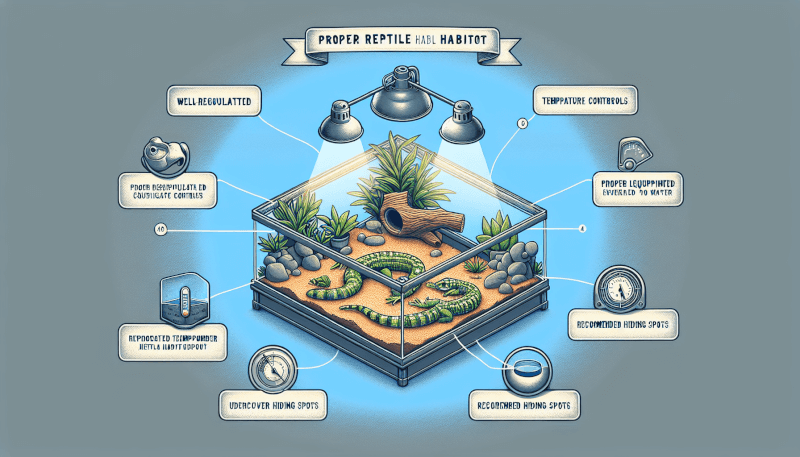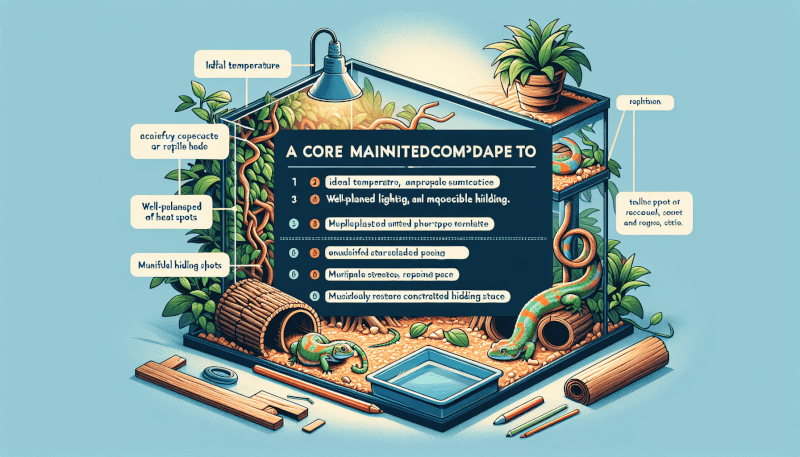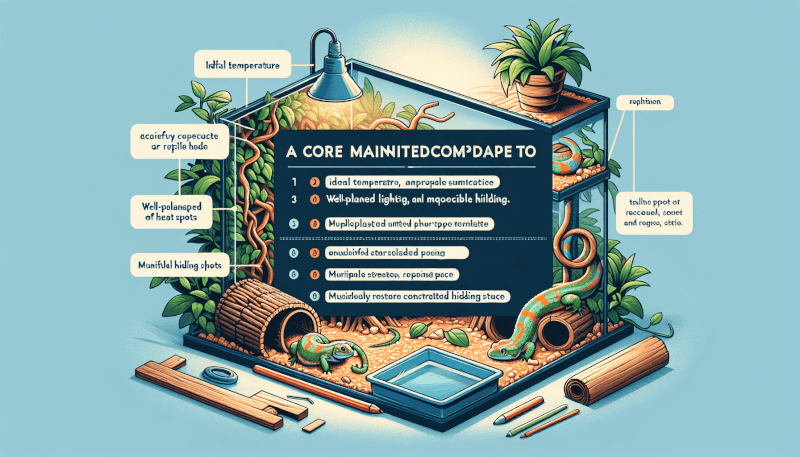If you’re a reptile enthusiast or considering getting a reptile as a pet, it’s important to create a proper habitat for your scaly companion. However, there are common mistakes that many reptile owners unknowingly make, which can negatively impact the overall well-being of their reptiles. In this article, you will discover the best reptile habitat mistakes to avoid, ensuring that your reptile thrives in a happy and healthy environment.

Not Providing the Right Temperature
Insufficient Heating
One of the most common mistakes reptile owners make is not providing sufficient heating in their habitats. Reptiles are ectothermic creatures, meaning they rely on external sources of heat to regulate their body temperature. Without proper heating, reptiles can become lethargic, lose their appetite, and even develop health issues.
To avoid this mistake, it is essential to research the specific heating requirements of the reptile species you are keeping. Different reptiles have different temperature requirements, so it is crucial to provide them with a suitable heat source such as heat lamps or heating pads. Make sure to monitor the temperature regularly using a thermometer and adjust it accordingly to maintain a stable and comfortable environment for your reptile.
Excessive Heat
While insufficient heating can be detrimental to reptiles, excessive heat can also be harmful. Some reptiles require a basking area where they can thermoregulate and reach a higher temperature, but it’s important not to overdo it. Providing excessively high temperatures can lead to dehydration, burns, and stress.
To avoid this mistake, always carefully research the temperature preferences of your reptile species. Provide a suitable temperature gradient within the habitat, allowing your reptile to move between warmer and cooler areas as necessary. It’s also crucial to regularly check the temperature and use thermostats or dimmers to regulate heating devices effectively.
Inadequate Humidity Levels
Low Humidity
Humidity plays a vital role in maintaining the health and well-being of many reptile species, especially those originating from tropical or humid environments. Insufficient humidity can lead to difficulties shedding their skin, respiratory issues, and even dehydration.
To avoid the mistake of low humidity, research the specific humidity requirements of your reptile species. Measures such as misting the habitat with water, using a humidifier, or providing a moist hide can help maintain adequate humidity levels. Regular monitoring of humidity with a hygrometer is crucial to ensure it stays within the required range.
High Humidity
While some reptiles thrive in high humidity environments, it’s important to note that not all reptile species have the same humidity requirements. Excessive humidity can promote the growth of harmful bacteria and fungi, leading to respiratory infections or skin problems in reptiles that prefer drier conditions.
To avoid the mistake of high humidity, carefully research the optimal humidity range for your reptile species. Ensure proper ventilation within the habitat to prevent excessive moisture buildup. Use a hygrometer to monitor humidity levels regularly and make necessary adjustments, such as reducing misting or providing better airflow.
Using the Wrong Substrate
Incorrect Substrate Choice
Choosing the wrong substrate for your reptile’s habitat can have significant consequences on their health and well-being. Different reptile species have different substrate preferences based on their natural habitats. Using the wrong substrate can lead to respiratory issues, ingestion of harmful materials, or even injuries.
To avoid this mistake, research the specific substrate requirements of your reptile species. Consider factors such as moisture retention, ease of cleaning, and the reptile’s natural environment. Common substrate options include reptile carpet, coconut fiber, and paper towels. Avoid using substrates that could be ingested, such as sand or wood chips, as they can cause digestive problems if consumed.
Improper Substrate Depth
Even if you choose the correct substrate, the depth at which it is placed within the habitat is crucial for the well-being of your reptile. Inadequate substrate depth can prevent reptiles from engaging in natural behaviors like burrowing or tunneling.
To avoid this mistake, provide a substrate depth that accommodates the natural behaviors of your reptile species. For burrowing species, a deeper layer of substrate is necessary to allow them to create tunnels and hide. However, for reptiles that don’t require burrowing, a shallower layer may be sufficient. Regularly monitor and clean the substrate to maintain hygiene and prevent the buildup of waste.
Poor Lighting Setup
Insufficient UVB Lighting
Proper lighting is essential for reptiles, as many rely on ultraviolet (UV) light to synthesize vitamin D3, crucial for calcium metabolism. Without sufficient UVB lighting, reptiles are at risk of developing metabolic bone disease, which weakens their bones and can lead to serious health issues.
To avoid this mistake, research the lighting requirements of your reptile species, including the need for UVB rays. Provide high-quality UVB bulbs specifically designed for reptiles, ensuring they emit the appropriate wavelengths. Position the lights correctly to create a gradient within the habitat, allowing reptiles to access both UVB and cooler areas. It’s also important to regularly replace UVB bulbs, as they lose their effectiveness over time.
Incorrect Light Cycle
In addition to providing sufficient UVB lighting, maintaining a proper light cycle is crucial for the overall well-being of reptiles. Many reptiles require a regular day-night cycle to regulate their behavior, metabolism, and sleep patterns. Disrupting this cycle can lead to stress, appetite loss, or even reproductive issues.
To avoid this mistake, mimic the natural lighting patterns of your reptile’s native habitat. Provide a consistent and regular light cycle, including a period of darkness for nocturnal species. Use timers to automate the lighting cycle, ensuring consistency and reducing the risk of human error. Proper light cycle management will help promote natural behaviors and the overall health of your reptile.

Lack of Hiding Places
Insufficient Hideouts
Creating a habitat that lacks hiding places can significantly impact the emotional well-being of your reptile. Hiding spots provide a sense of security and privacy, allowing reptiles to retreat when they feel stressed or threatened. Without adequate hideouts, reptiles may become constantly stressed, leading to behavioral issues and a decline in overall health.
To avoid this mistake, incorporate various hiding places within your reptile’s habitat. This can include natural or artificial caves, branches, or hollow logs that provide a secluded space. Ensure that the hiding places are appropriately sized for your reptile, allowing them to comfortably fit inside. Placing hideouts in both the warm and cool areas of the habitat allows reptiles to choose the suitable microclimate for their needs.
Inadequate Climbing Structures
Many reptile species, such as arboreal or semi-arboreal, have a natural inclination to climb or perch. Neglecting to provide appropriate climbing structures can deprive them of a vital aspect of their natural behavior and mental stimulation. Without suitable climbing structures, reptiles may become bored, lethargic, or stressed.
To avoid this mistake, research the specific climbing needs of your reptile species. Incorporate branches, vines, or platforms within the habitat, creating opportunities for climbing and perching. Ensure the climbing structures are sturdy and securely anchored to prevent accidents or injuries. Regularly inspect and clean the climbing structures to maintain hygiene and safety.
Incorrect Feeding Techniques
Wrong Food Selection
Feeding reptiles a diet that doesn’t meet their nutritional needs can lead to serious health problems over time. Different reptile species have varying dietary requirements, including specific prey items or nutritional supplements. Providing the wrong food can result in malnutrition, metabolic disorders, or obesity.
To avoid this mistake, thoroughly research the dietary needs of your reptile species. Identify the proper prey items they require, whether it’s insects, fruits, vegetables, or specialized diets. Consider adding appropriate calcium and vitamin supplements as recommended by reptile experts or veterinarians. Regularly review and adjust the diet to ensure it provides the necessary nutrients for your reptile’s optimal health.
Overfeeding or Underfeeding
Finding the right balance in feeding your reptile is crucial, as both overfeeding and underfeeding can have negative consequences. Overfeeding can lead to obesity, digestive issues, and reduced lifespan, while underfeeding can result in malnutrition and stunted growth.
To avoid this mistake, establish a feeding schedule that matches the needs of your reptile species. Consult reputable sources or seek guidance from a reptile expert to determine appropriate feeding frequencies and portion sizes. Monitor your reptile’s body condition regularly and adjust the feeding amounts as necessary. It’s also important to remove any uneaten food promptly to maintain cleanliness and prevent bacterial growth.

Neglecting Water Source
Inadequate Water Bowl
Providing a reliable and clean water source is essential for the hydration and overall well-being of your reptile. Neglecting to provide an adequate water bowl can lead to dehydration, especially for species that don’t obtain moisture from their food.
To avoid this mistake, choose a water bowl that is appropriately sized and easily accessible for your reptile. Ensure it is filled with clean, fresh water at all times. Reptiles may also benefit from a larger, shallow dish for soaking or a reptile dripper system to simulate natural water movement. Regularly clean and disinfect the water bowl to prevent the growth of harmful bacteria or parasites.
Improper Water Conditioning
Water quality is crucial for the health of your reptile. Tap water often contains chemicals such as chlorine or heavy metals that can be harmful when consumed or absorbed through the skin. Neglecting to condition or treat the water properly can result in adverse health effects and even fatalities.
To avoid this mistake, use water conditioners or dechlorinators specifically formulated for reptile habitats. These products remove harmful chemicals and neutralize toxins, making the water safe for your reptile to drink. It is important to follow the instructions provided by the manufacturer to ensure proper water conditioning. Regularly test the water quality to maintain a healthy and safe environment for your reptile.
Improper Handling and Stress
Rough Handling
Improper handling can cause significant stress to reptiles and even result in physical injuries. Reptiles may feel threatened or become defensive when mishandled, leading to aggression, anxiety, or attempts to escape.
To avoid this mistake, approach your reptile with gentleness and respect their boundaries. Learn proper handling techniques specific to your reptile species and be cautious of sharp claws, teeth, or tails. Avoid sudden movements or loud noises that can startle or stress your reptile. Allow them ample time to adjust to new environments before attempting handling. Always wash your hands before and after handling to prevent the transmission of any harmful bacteria.
Inadequate Resting Areas
Reptiles, like any animals, require a safe and comfortable place to rest and sleep. Neglecting to provide appropriate resting areas can lead to chronic stress, fatigue, and reduce the overall well-being of your reptile.
To avoid this mistake, include comfortable resting spots within your reptile’s habitat. This can be in the form of designated flat areas, branches, or platforms where they can fully stretch out or curl up. Choose materials that provide good insulation, such as reptile carpet or cork bark, ensuring they are clean and free from any sharp edges. Observe your reptile’s resting patterns to ensure they have a suitable and peaceful place to recharge.

Overlooking Regular Cleaning
Inadequate Waste Removal
Improper waste removal can lead to unsanitary conditions and put your reptile’s health at risk. Accumulated waste can release harmful gases, harbor parasites, or contribute to the growth of bacteria and fungi, resulting in respiratory issues or infections.
To avoid this mistake, regularly remove feces, shed skin, and any uneaten food from your reptile’s habitat. Spot clean as needed and establish a routine for thorough cleaning and disinfection. This may include removing and sanitizing accessories, replacing substrate, and deep cleaning the enclosure. Always use reptile-safe cleaning products and avoid harsh chemicals that may be toxic to your reptile.
Failure to Sterilize Accessories
Reptile habitats often include various accessories and equipment, such as hides, climbing structures, or water bowls. Neglecting to regularly clean and sterilize these items can lead to the growth of harmful bacteria or fungi, posing a health risk to your reptile.
To avoid this mistake, periodically clean and sterilize all accessories within your reptile’s habitat. For non-porous items, such as plastic hides, use reptile-safe disinfectants or a diluted bleach solution. Thoroughly rinse and air-dry all items before placing them back into the habitat. For porous materials, consider replacing them regularly to prevent the buildup of bacteria or fungi.
Ignoring Proper Ventilation
Insufficient Air Flow
Good ventilation is crucial to maintain air quality, control humidity, and prevent the build-up of harmful gases within your reptile’s habitat. Insufficient air flow can lead to stagnant air, excessive humidity, or the accumulation of harmful toxins.
To avoid this mistake, ensure proper ventilation within your reptile’s habitat. Provide ventilation grilles or screens on the enclosure to allow air circulation. Position heating or cooling devices in a way that does not obstruct air flow. Regularly check for any obstructions or debris that may hinder proper air exchange and remove them promptly. Monitoring temperature and humidity levels will also help ensure optimal ventilation.
Improper Cage Design
The design and layout of your reptile’s habitat can greatly impact their overall health and well-being. Neglecting to consider the proper cage design can lead to inadequate space, difficulty in maintaining temperature and humidity, or restrictions on the reptile’s natural behaviors.
To avoid this mistake, research the specific habitat requirements of your reptile species. Provide an enclosure with adequate space to allow for natural movements and behaviors. Include appropriate heating and lighting equipment, as well as hiding spots and climbing structures. Ensure the enclosure is escape-proof and made of suitable materials for your reptile’s safety. Regularly assess and adjust the cage design to meet the changing needs of your reptile.
In conclusion, creating and maintaining a suitable habitat for your reptile requires careful consideration and attention to detail. Avoiding the common mistakes discussed above will help ensure the health, happiness, and longevity of your reptile companion. Remember to research the specific needs of your reptile species, monitor their environment regularly, and seek advice from reputable sources or reptile experts when necessary. With proper care and a well-designed habitat, you can provide your reptile with a comfortable and thriving living space.



